2018 NISSAN VERSA engine coolant
[x] Cancel search: engine coolantPage 278 of 354
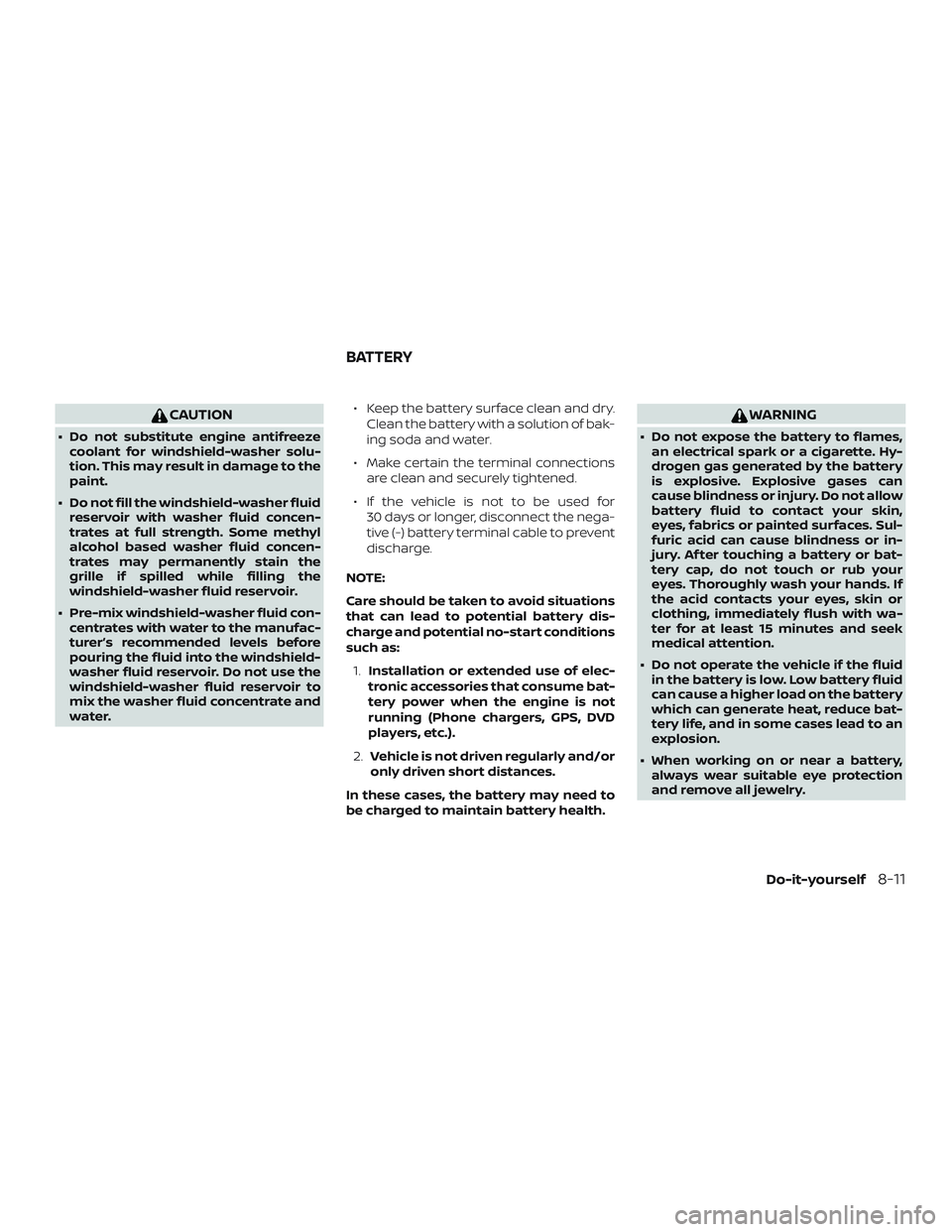
CAUTION
∙ Do not substitute engine antifreeze
coolant for windshield-washer solu-
tion. This may result in damage to the
paint.
∙ Do not fill the windshield-washer fluid
reservoir with washer fluid concen-
trates at full strength. Some methyl
alcohol based washer fluid concen-
trates may permanently stain the
grille if spilled while filling the
windshield-washer fluid reservoir.
∙ Pre-mix windshield-washer fluid con-
centrates with water to the manufac-
turer’s recommended levels before
pouring the fluid into the windshield-
washer fluid reservoir. Do not use the
windshield-washer fluid reservoir to
mix the washer fluid concentrate and
water.∙ Keep the battery surface clean and dry.
Clean the battery with a solution of bak-
ing soda and water.
∙ Make certain the terminal connections
are clean and securely tightened.
∙ If the vehicle is not to be used for
30 days or longer, disconnect the nega-
tive (-) battery terminal cable to prevent
discharge.
NOTE:
Care should be taken to avoid situations
that can lead to potential battery dis-
charge and potential no-start conditions
such as:
1.Installation or extended use of elec-
tronic accessories that consume bat-
tery power when the engine is not
running (Phone chargers, GPS, DVD
players, etc.).
2.Vehicle is not driven regularly and/or
only driven short distances.
In these cases, the battery may need to
be charged to maintain battery health.
WARNING
∙ Do not expose the battery to flames,
an electrical spark or a cigarette. Hy-
drogen gas generated by the battery
is explosive. Explosive gases can
cause blindness or injury. Do not allow
battery fluid to contact your skin,
eyes, fabrics or painted surfaces. Sul-
furic acid can cause blindness or in-
jury. Af ter touching a battery or bat-
tery cap, do not touch or rub your
eyes. Thoroughly wash your hands. If
the acid contacts your eyes, skin or
clothing, immediately flush with wa-
ter for at least 15 minutes and seek
medical attention.
∙ Do not operate the vehicle if the fluid
in the battery is low. Low battery fluid
can cause a higher load on the battery
which can generate heat, reduce bat-
tery life, and in some cases lead to an
explosion.
∙ When working on or near a battery,
always wear suitable eye protection
and remove all jewelry.
BATTERY
Do-it-yourself8-11
Page 311 of 354
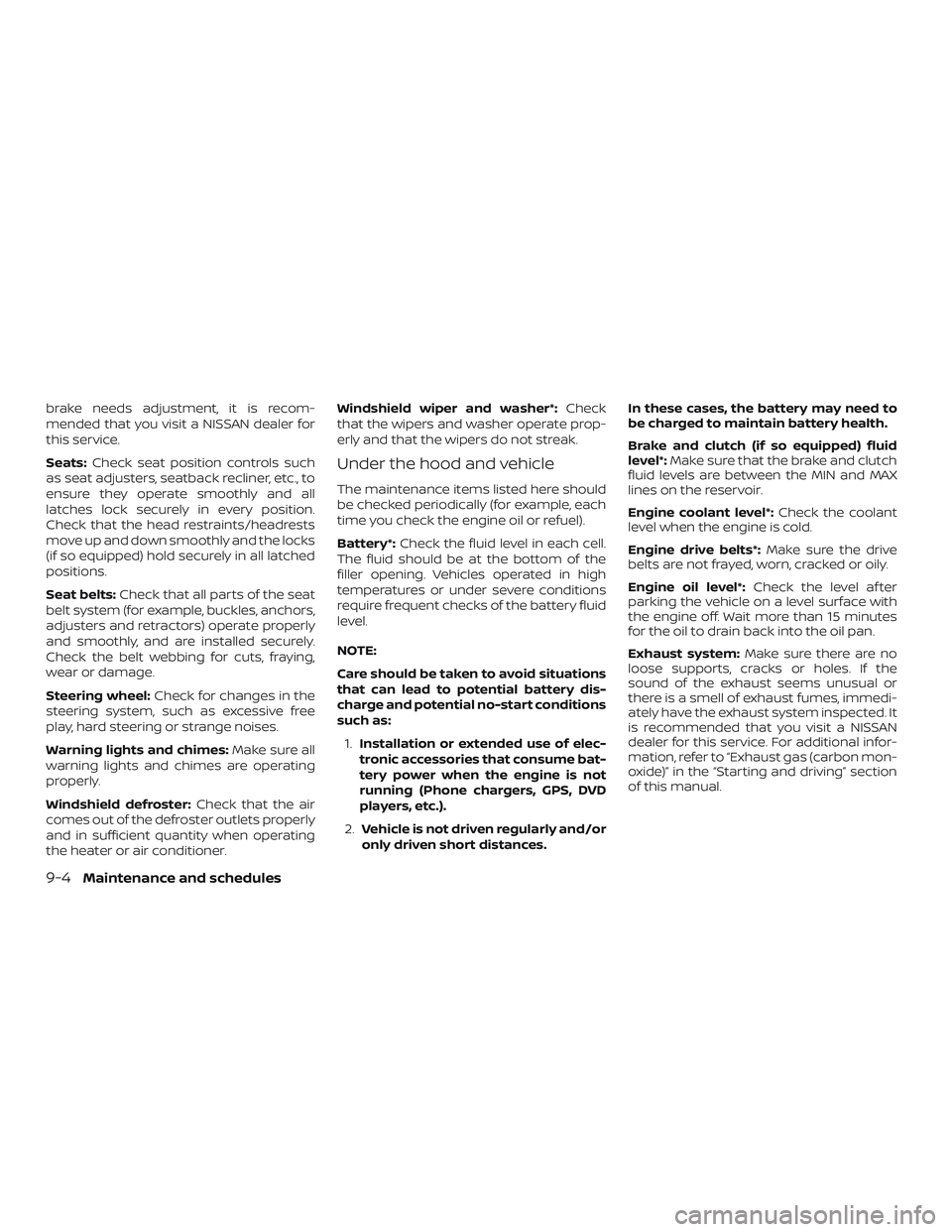
brake needs adjustment, it is recom-
mended that you visit a NISSAN dealer for
this service.
Seats:Check seat position controls such
as seat adjusters, seatback recliner, etc., to
ensure they operate smoothly and all
latches lock securely in every position.
Check that the head restraints/headrests
move up and down smoothly and the locks
(if so equipped) hold securely in all latched
positions.
Seat belts:Check that all parts of the seat
belt system (for example, buckles, anchors,
adjusters and retractors) operate properly
and smoothly, and are installed securely.
Check the belt webbing for cuts, fraying,
wear or damage.
Steering wheel:Check for changes in the
steering system, such as excessive free
play, hard steering or strange noises.
Warning lights and chimes:Make sure all
warning lights and chimes are operating
properly.
Windshield defroster:Check that the air
comes out of the defroster outlets properly
and in sufficient quantity when operating
the heater or air conditioner.Windshield wiper and washer*:Check
that the wipers and washer operate prop-
erly and that the wipers do not streak.
Under the hood and vehicle
The maintenance items listed here should
be checked periodically (for example, each
time you check the engine oil or refuel).
Battery*:Check the fluid level in each cell.
The fluid should be at the bottom of the
filler opening. Vehicles operated in high
temperatures or under severe conditions
require frequent checks of the battery fluid
level.
NOTE:
Care should be taken to avoid situations
that can lead to potential battery dis-
charge and potential no-start conditions
such as:
1.Installation or extended use of elec-
tronic accessories that consume bat-
tery power when the engine is not
running (Phone chargers, GPS, DVD
players, etc.).
2.Vehicle is not driven regularly and/or
only driven short distances.In these cases, the battery may need to
be charged to maintain battery health.
Brake and clutch (if so equipped) fluid
level*:Make sure that the brake and clutch
fluid levels are between the MIN and MAX
lines on the reservoir.
Engine coolant level*:Check the coolant
level when the engine is cold.
Engine drive belts*:Make sure the drive
belts are not frayed, worn, cracked or oily.
Engine oil level*:Check the level af ter
parking the vehicle on a level surface with
the engine off. Wait more than 15 minutes
for the oil to drain back into the oil pan.
Exhaust system:Make sure there are no
loose supports, cracks or holes. If the
sound of the exhaust seems unusual or
there is a smell of exhaust fumes, immedi-
ately have the exhaust system inspected. It
is recommended that you visit a NISSAN
dealer for this service. For additional infor-
mation, refer to “Exhaust gas (carbon mon-
oxide)” in the “Starting and driving” section
of this manual.
9-4Maintenance and schedules
Page 313 of 354

Engine coolant*:Replace coolant at the
specified interval. When adding or replac-
ing coolant, be sure to use only Genuine
NISSAN Long Life Antifreeze/Coolant (blue)
or equivalent with the proper mixture. (For
additional information on the proper mix-
ture for your area, refer to “Engine cooling
system” in the “Do-it-yourself ” section of
this manual.)
NOTE: Mixing any other type of coolant
or the use of non-distilled water may re-
duce the recommended service interval
of the coolant.
Engine oil and oil filter:Replace engine oil
and oil filter at the specified intervals. For
recommended oil grade and viscosity refer
to “Recommended fluids/lubricants and
capacities” in the “Technical and consumer
information” section of this manual.
Fuel lines*:Check the fuel hoses, piping
and connections for leaks, looseness, or
deterioration. Tighten connections or re-
place parts as necessary.
Spark plugs:Replace at specified intervals.
Install new plugs of the type as originally
equipped.CHASSIS AND BODY
MAINTENANCE:
Brake lines and cables:Visually inspect for
proper installation. Check for chafing,
cracks, deterioration, and signs of leaking.
Replace any deteriorated or damaged
parts immediately.
Brake pads, rotors, drums and linings:
Check for wear, deterioration and fluid
leaks. Replace any deteriorated or dam-
aged parts immediately.
Exhaust system:Visually inspect the ex-
haust pipes, muffler and hangers for leaks,
cracks, deterioration, and damage. Tighten
connections or replace parts as necessary.
Steering gear and linkage, axle and sus-
pension parts, drive shaf t boots:Check
for damage, looseness, and leakage of oil
or grease. Under severe driving conditions,
inspect more frequently.
Tire rotation:Tires should be rotated every
5,000 miles (8,000 km) according to the in-
structions under “General maintenance” in
this section. When rotating tires, check for
damage and uneven wear. Replace if nec-
essary.Transmission fluid/oil:Visually inspect for
signs of leakage at specified intervals.
If towing a trailer, using a camper or car-top
carrier, or driving on rough or muddy roads,
replace the CVT fluid every 60,000 miles
(96,000 km) or request the dealer to inspect
the fluid deterioration data using a CON-
SULT. If the deterioration data is more than
210000, replace the CVT fluid.
9-6Maintenance and schedules
Page 315 of 354
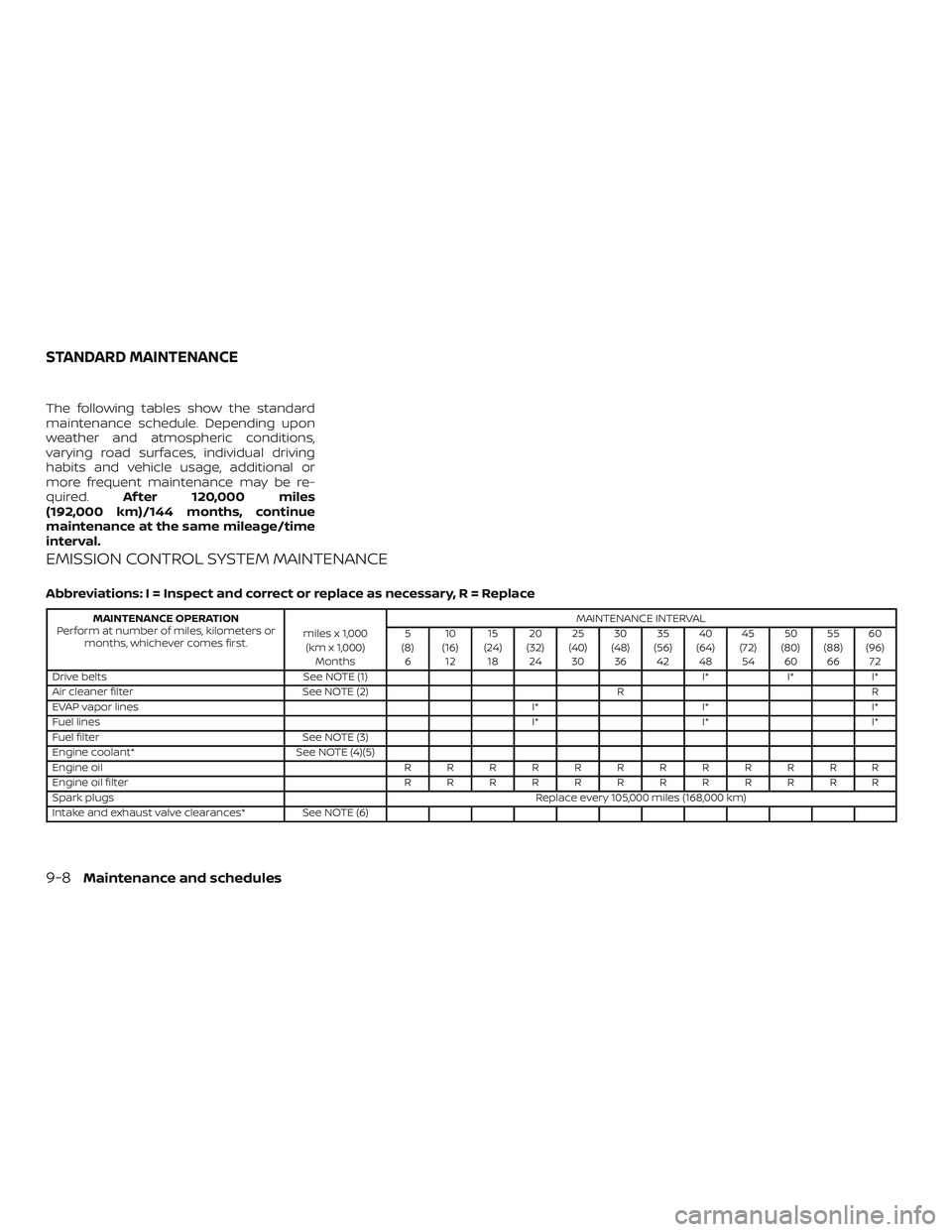
The following tables show the standard
maintenance schedule. Depending upon
weather and atmospheric conditions,
varying road surfaces, individual driving
habits and vehicle usage, additional or
more frequent maintenance may be re-
quired.Af ter 120,000 miles
(192,000 km)/144 months, continue
maintenance at the same mileage/time
interval.
EMISSION CONTROL SYSTEM MAINTENANCE
Abbreviations: I = Inspect and correct or replace as necessary, R = Replace
MAINTENANCE OPERATION
Perform at number of miles, kilometers or
months, whichever comes first.miles x 1,000
(km x 1,000)
MonthsMAINTENANCE INTERVAL
5
(8)
610
(16)
1215
(24)
1820
(32)
2425
(40)
3030
(48)
3635
(56)
4240
(64)
4845
(72)
5450
(80)
6055
(88)
6660
(96)
72
Drive belts See NOTE (1) I* I* I*
Air cleaner filter See NOTE (2) R R
EVAP vapor linesI* I* I*
Fuel linesI* I* I*
Fuel filter See NOTE (3)
Engine coolant* See NOTE (4)(5)
Engine oilRRRRRRRRRRRR
Engine oil filterRRRRRRRRRRRR
Spark plugsReplace every 105,000 miles (168,000 km)
Intake and exhaust valve clearances* See NOTE (6)
STANDARD MAINTENANCE
9-8Maintenance and schedules
Page 316 of 354
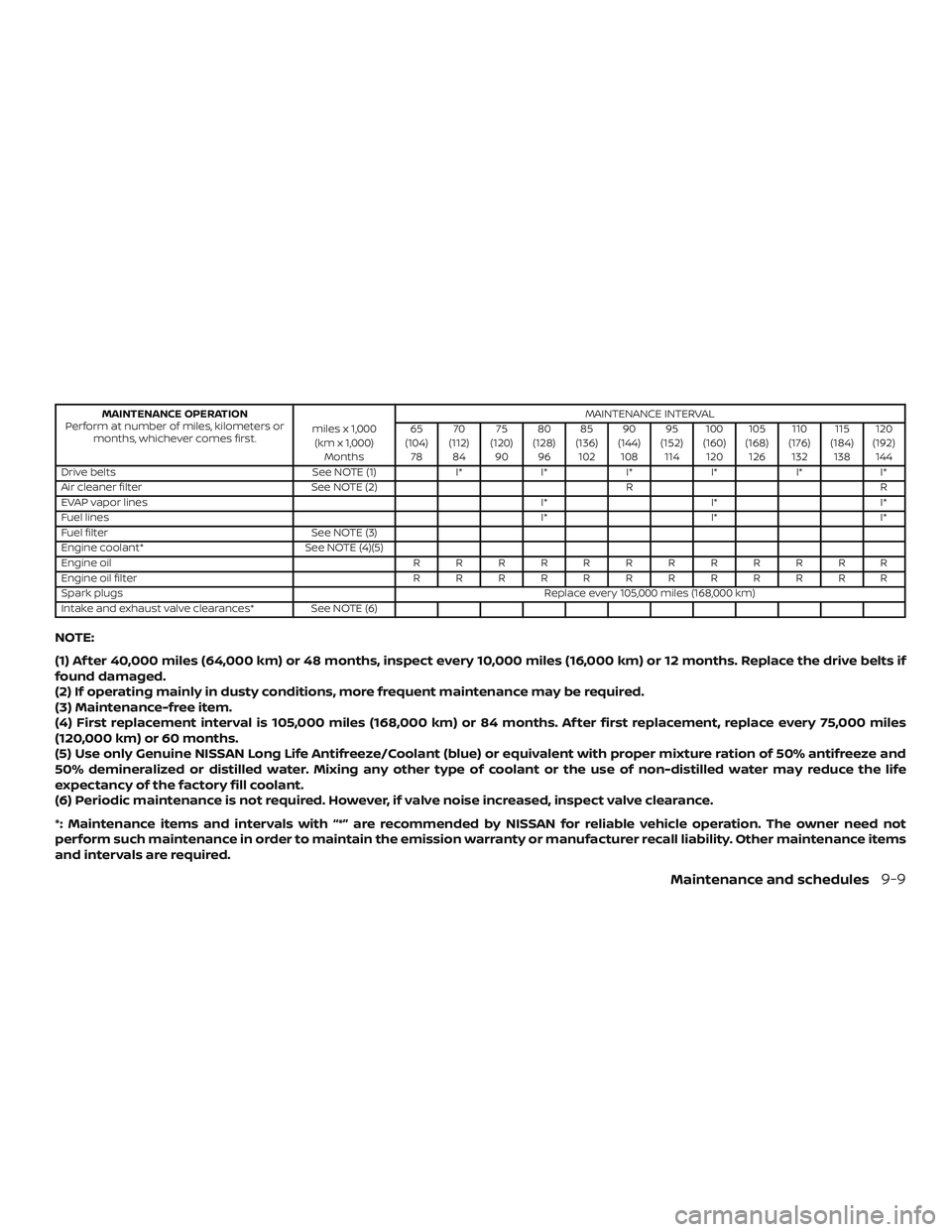
MAINTENANCE OPERATION
Perform at number of miles, kilometers or
months, whichever comes first.miles x 1,000
(km x 1,000)
MonthsMAINTENANCE INTERVAL
65
(104)
7870
(112)
8475
(120)
9080
(128)
9685
(136)
10290
(144)
10895
(152)
114100
(160)
120105
(168)
126110
(176)
132115
(184)
138120
(192)
144
Drive belts See NOTE (1) I* I* I* I* I* I*
Air cleaner filter See NOTE (2) R R
EVAP vapor linesI* I* I*
Fuel linesI* I* I*
Fuel filter See NOTE (3)
Engine coolant* See NOTE (4)(5)
Engine oilRRRRRRRRRRRR
Engine oil filterRRRRRRRRRRRR
Spark plugsReplace every 105,000 miles (168,000 km)
Intake and exhaust valve clearances* See NOTE (6)
NOTE:
(1) Af ter 40,000 miles (64,000 km) or 48 months, inspect every 10,000 miles (16,000 km) or 12 months. Replace the drive belts if
found damaged.
(2) If operating mainly in dusty conditions, more frequent maintenance may be required.
(3) Maintenance-free item.
(4) First replacement interval is 105,000 miles (168,000 km) or 84 months. Af ter first replacement, replace every 75,000 miles
(120,000 km) or 60 months.
(5) Use only Genuine NISSAN Long Life Antifreeze/Coolant (blue) or equivalent with proper mixture ration of 50% antifreeze and
50% demineralized or distilled water. Mixing any other type of coolant or the use of non-distilled water may reduce the life
expectancy of the factory fill coolant.
(6) Periodic maintenance is not required. However, if valve noise increased, inspect valve clearance.
*: Maintenance items and intervals with “*” are recommended by NISSAN for reliable vehicle operation. The owner need not
perform such maintenance in order to maintain the emission warranty or manufacturer recall liability. Other maintenance items
and intervals are required.
Maintenance and schedules9-9
Page 325 of 354
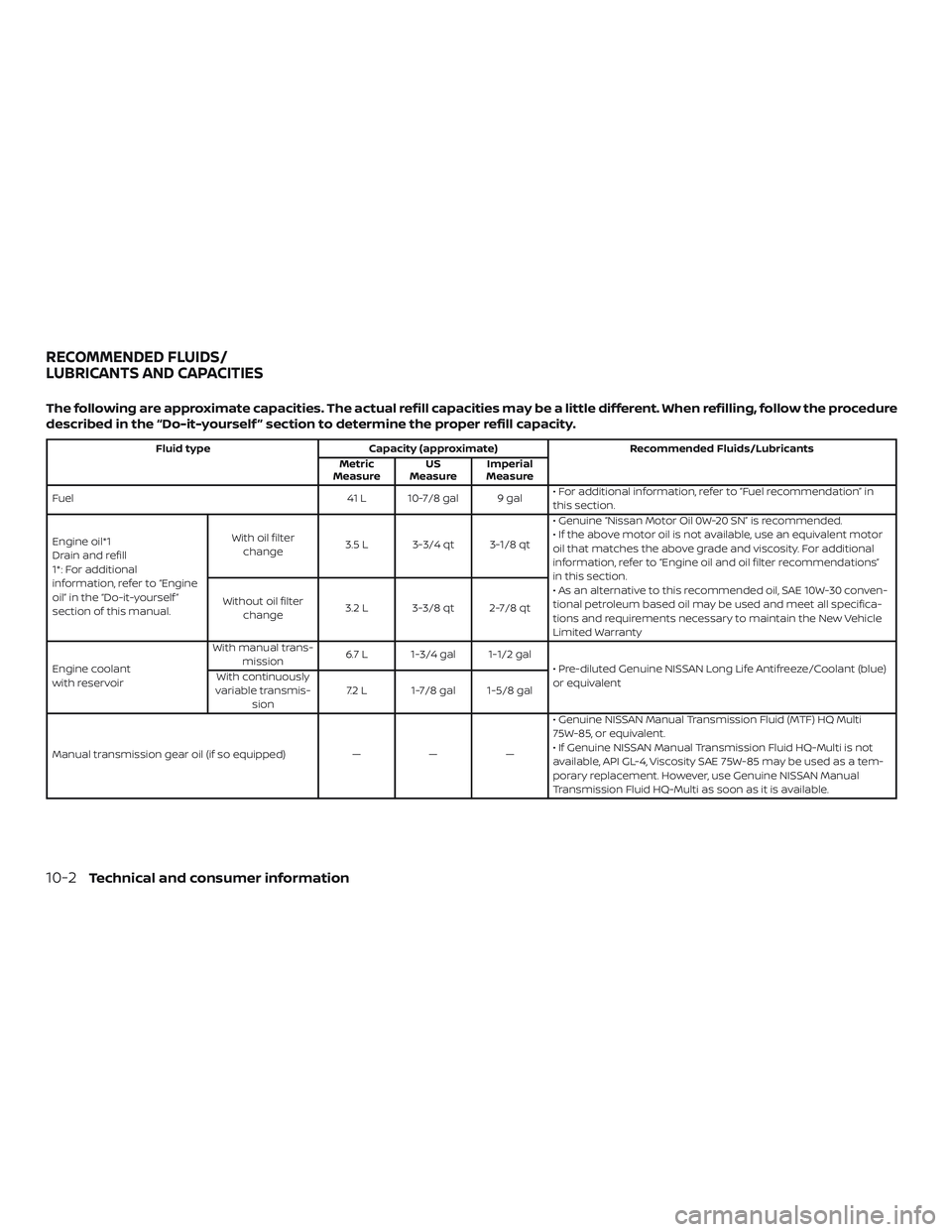
The following are approximate capacities. The actual refill capacities may be a little different. When refilling, follow the procedure
described in the “Do-it-yourself ” section to determine the proper refill capacity.
Fluid type Capacity (approximate) Recommended Fluids/Lubricants
Metric
MeasureUS
MeasureImperial
Measure
Fuel 41 L 10-7/8 gal 9 gal• For additional information, refer to “Fuel recommendation” in
this section.
Engine oil*1
Drain and refill
1*: For additional
information, refer to “Engine
oil” in the “Do-it-yourself ”
section of this manual.With oil filter
change3.5 L 3-3/4 qt 3-1/8 qt• Genuine “Nissan Motor Oil 0W-20 SN” is recommended.
• If the above motor oil is not available, use an equivalent motor
oil that matches the above grade and viscosity. For additional
information, refer to “Engine oil and oil filter recommendations”
in this section.
• As an alternative to this recommended oil, SAE 10W-30 conven-
tional petroleum based oil may be used and meet all specifica-
tions and requirements necessary to maintain the New Vehicle
Limited Warranty Without oil filter
change3.2 L 3-3/8 qt 2-7/8 qt
Engine coolant
with reservoirWith manual trans-
mission6.7 L 1-3/4 gal 1-1/2 gal
• Pre-diluted Genuine NISSAN Long Life Antifreeze/Coolant (blue)
or equivalent With continuously
variable transmis-
sion7.2 L 1-7/8 gal 1-5/8 gal
Manual transmission gear oil (if so equipped) — — —• Genuine NISSAN Manual Transmission Fluid (MTF) HQ Multi
75W-85, or equivalent.
• If Genuine NISSAN Manual Transmission Fluid HQ-Multi is not
available, API GL-4, Viscosity SAE 75W-85 may be used as a tem-
porary replacement. However, use Genuine NISSAN Manual
Transmission Fluid HQ-Multi as soon as it is available.
RECOMMENDED FLUIDS/
LUBRICANTS AND CAPACITIES
10-2Technical and consumer information
Page 347 of 354

CD player
(See audio system).......4-29,4-35,4-40
Childrestraints........1-18, 1-19, 1-20, 1-23
LATCH (Lower Anchors and Tethers for
CHildren)System..............1-23
Precautions on child
restraints .........1-20, 1-27, 1-33, 1-38
Top tether strap anchor point
locations...................1-25
Child safety rear door lock..........3-5
Chimes, audible reminders.........2-20
Cleaningexteriorandinterior......7-2,7-4
Clock set/adjustment . .4-28, 4-33, 4-34, 4-37
Clock setting (models without Navigation
System)..................4-28,4-39
Clutch
Clutchfluid.................8-10
Coldweatherdriving.............5-29
Compact disc (CD) player . . .4-29, 4-35, 4-40
Continuously Variable Transmission
(CVT).....................5-8,5-11
Continuously Variable Transmission
(CVT) fluid...................8-9
Driving with Continuously Variable
Transmission (CVT)..........5-8,5-11
Controls
Audio controls (steering wheel)....4-48
Heater and air conditioner controls . . .4-9
Coolant
Capacities and recommended
fuel/lubricants...............10-2
Changing engine coolant.........8-5
Checking engine coolant level......8-5
Engine coolant temperature gauge . .2-8
Corrosionprotection..............7-7
Cruisecontrol..................5-19Cupholders...................2-29
Curtain side-impact and rollover air
bag........................1-57
D
Defroster switch
Rearwindowdefrosterswitch.....2-22
Dimensions and weights...........10-9
Dimmer switch for instrument panel . . .2-23
Door locks..................3-3,3-4
Door open warning light...........2-14
Drivebelt ....................8-14
Driving
Cold weather driving...........5-29
Driving with Continuously Variable
Transmission (CVT)..........5-8,5-11
Driving with manual
transmission..............5-9,5-16
Precautions when starting and
driving.....................5-2
Drivingthevehicle...............5-11
E
Economy - fuel.................5-22
Emission control information label. . . .10-11
Emission control system warranty . . . .10-19
Engine
Before starting the engine........5-10
Blockheater ................5-31
Capacities and recommended
fuel/lubricants...............10-2
Changing engine coolant.........8-5Changing engine oil............8-7
Changing engine oil filter.........8-8
Checking engine coolant level......8-5
Checking engine oil level.........8-6
Engine compartment check
locations...................8-3
Engine coolant temperature gauge . .2-8
Engine cooling system..........8-4
Engine oil...................8-6
Engine oil and oil filter
recommendation.............10-6
Engine oil pressure warning light....2-14
Engine oil viscosity.............10-7
Engine serial number...........10-11
Engine specifications...........10-8
Starting the engine............5-10
Engine coolant temperature gauge....2-8
EventDatarecorders ............10-21
Exhaust gas (Carbon monoxide).......5-2
Explanation of maintenance items.....9-2
Explanation of scheduled maintenance
items .......................9-5
Extended storage switch..........8-20
F
Flashers
(Seehazardwarningflasherswitch)....6-2
Flattire....................6-2,6-3
Floormatpositioningaid...........7-6
Fluid
Brakefluid..................8-9
Capacities and recommended
fuel/lubricants...............10-2
Clutchfluid.................8-10
11-2
Page 348 of 354

Continuously Variable Transmission
(CVT) fluid...................8-9
Engine coolant...............8-4
Engine oil...................8-6
F.M.V.S.S. certification label..........10-11
Foglightswitch................2-25
Front air bag system (See supplemental
restraint system)................1-51
Frontseats....................1-2
Fuel
Capacities and recommended
fuel/lubricants...............10-2
Fuel economy...............5-22
Fuel-filler cap................3-13
Fuel-filler door lock opener lever....3-13
Fuel-filler lid.................3-13
Fuel gauge..................2-9
Fueloctanerating.............10-5
Fuel recommendation..........10-4
Loose fuel cap warning..........2-6
Fuelefficientdrivingtips...........5-21
Fuel-filler door.................3-13
Fuel gauge....................2-9
Fuses.......................8-18
Fusiblelinks...................8-18
G
Gascap .....................3-13
Gauge
Engine coolant temperature gauge . .2-8
Fuel gauge..................2-9
Odometer..................2-6
Speedometer................2-5
Tachometer.................2-8Trip computer...............2-10
Trip odometer.............2-5,2-6
General maintenance.............9-2
Glovebox....................2-28
H
Hands-free phone system,
Bluetooth®................4-50,4-65
Hazard warning flasher switch........6-2
Headlight and turn signal switch......2-22
Headlightcontrolswitch...........2-22
Headlights ...................8-22
Headrestraints .................1-5
Heater
Heater and air conditioner controls . . .4-9
Heater operation..............4-11
Hood.......................3-10
Horn.......................2-25
I
Ignition switch..................5-8
Important vehicle information label. . . .10-11
Increasing fuel economy...........5-22
Indicator lights and audible reminders
(See warning/indicator lights and audible
reminders)....................2-18
Instrument brightness control.......2-23
Instrument panel.............0-6,2-2
Instrument panel dimmer switch.....2-23
Interiorlight ...............2-32,2-33
Interiortrunklidrelease ...........3-12
iPod®Player ..................4-44ISOFIX child restraints.............1-23
J
Jumpstarting...............6-8,8-13
K
Key.........................3-2
Key fob battery replacement.....8-20,8-21
Keyless entry
Without Intelligent Key system
(See remote keyless entry system). .3-6, 3-7
L
Labels
Air conditioner specification label . . .10-12
Emission control information label . .10-11
Engine serial number...........10-11
F.M.V.S.S. certification label........10-11
Tire and Loading Information label . .10-12
Vehicle identification number (VIN) . .10-10
Vehicle identification number (VIN)
plate.....................10-10
Warning labels (for SRS)..........1-59
LATCH (Lower Anchors and Tethers for
CHildren)System................1-23
License plate
Installing the license plate.......10-12
Light
Airbagwarninglight........1-60, 2-17
Brakelight(Seestoplight)........8-24
11-3